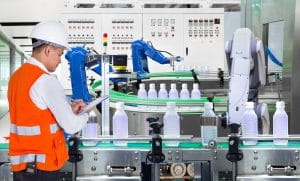 Cooling electrical enclosures and control panels is one of the most common uses for modern heat exchangers. It’s a vital process for keeping technology operating properly, and since all industries rely on technology, implementing more efficient and reliable thermal management systems is essential. Heat exchangers typically provide the optimal solution for electrical thermal management – yet, in some industries, enclosure cooling is only one of several highly important thermal management concerns. Fortunately, heat exchangers can often be used to efficiently meet those needs, such as the complex thermal management requirements that come with food and beverage production.
Cooling electrical enclosures and control panels is one of the most common uses for modern heat exchangers. It’s a vital process for keeping technology operating properly, and since all industries rely on technology, implementing more efficient and reliable thermal management systems is essential. Heat exchangers typically provide the optimal solution for electrical thermal management – yet, in some industries, enclosure cooling is only one of several highly important thermal management concerns. Fortunately, heat exchangers can often be used to efficiently meet those needs, such as the complex thermal management requirements that come with food and beverage production.
Thermal management concerns for the industry
Efficient, eco-friendly electrical cooling has become more vital in the food and beverage industry as companies implement advanced technological solutions, such as automated machinery. The advancement of heat exchangers has made it easier and more convenient for food and beverage companies to streamline their operations without significantly rising costs. However, manufacturing food and beverage products also involves processes such as storage within properly chilled areas and pasteurization that requires the steady application of heat. Such processes also require high-performance thermal management capabilities that heat exchangers can often be designed to meet just as efficiently.
Enhancing production and efficiency
The reason heat exchangers have become so popular in all industries is because electrical thermal management has traditionally been a noticeable burden on companies’ operations. Before them, companies relied on solutions like air conditioning and air compression to cool their technology. While effective to a degree, these solutions are not only costly to operate, but often can’t meet the heightened thermal management demands of more advanced technology. By streamlining their electrical thermal management with the help of heat exchangers, companies could grow and evolve their operations without having to invest more heavily in their cooling systems.
Improving safety and product quality
The way heat exchangers improve production and efficiency is by applying high-performance heat transfer methods to the sphere of electrical cooling. For example, one of the reasons more traditional solutions are so costly is because they require large amounts of energy. In many cases, they require frequent maintenance due to wear and tear on complicated cooling unit parts. By contrast, heat exchangers utilize methods like convection and phase-change cooling to transfer heat in a more eco-friendly manner. This not only reduces energy and maintenance needs, but also helps food and beverage companies perform processes such as pasteurization safer and with more consistently satisfactory results.
For more information about other heat exchanger applications in the food and beverage industry, call Noren Thermal Solutions in Taylor, TX, at 866-936-6736.







